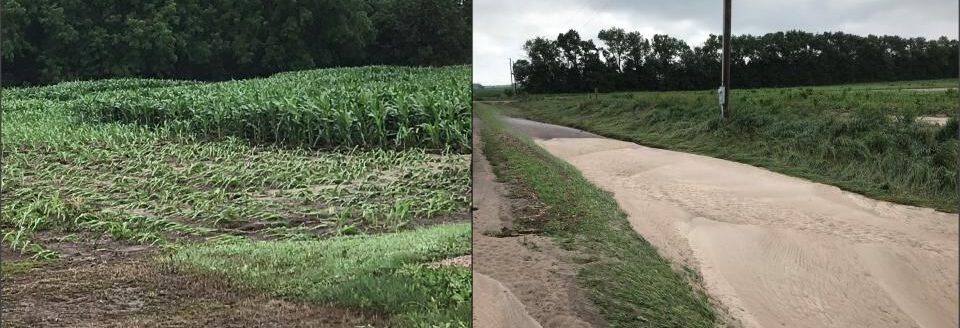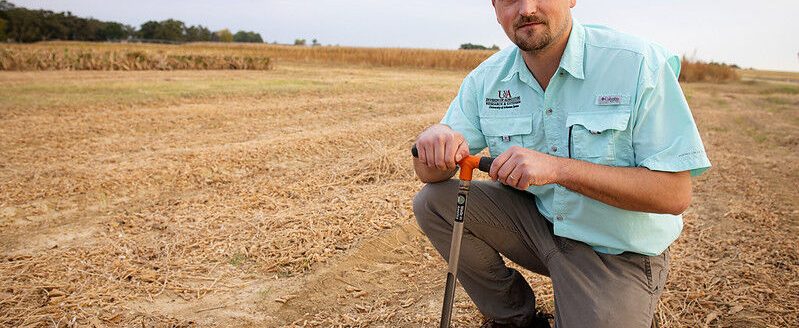App helps curb phosphorus losses
Designing an on-farm system for removing phosphorus in field runoff or subsurface drainage could become easier to do thanks to the "P-Trap," a new software program from Agricultural Research Service scientists and their collaborators.
In agricultural production systems, phosphorus is a critical nutrient for optimal plant growth, health and yield. But phosphorus that leaves agricultural fields in runoff or drainage water can end up in water bodies like lakes, streams and rivers, compromising their quality, fueling algal blooms and imperiling aquatic life as well as recreational activities. Management practices and technologies that prevent phosphorus loss is vital to maintaining environmental quality. One promising technology is an engineered system that removes phosphorus from runoff or drainage water as it leaves a field.
There are a variety of ways to design, build and install a phosphorus removal system. However, deciding which system is best for a specific farm operation or crop field configuration can be daunting, noted Chad Penn. He is a soil scientist at the ARS National Soil Erosion Research Unit in West Lafayette, Indiana, who is conducting intensive field research on phosphorus removal systems.
The P-Trap ("Phosphorus Transport Reduction") software streamlines the process by asking the user to enter four basic categories of information, starting with a drop-down menu offering different design options. The program then calculates specifications for building the structure based on data the user entered, including expected water-flow rates, annual volume, dissolved phosphorus concentration in water, drainage ditch depth and slope, pipe diameter and desired phosphorus removal rate.
The P-Trap isn’t just a decision-aid, though; it can also evaluate the effectiveness of an existing design that’s already in use and offer recommendations to improve it.
Penn noted that regardless of design, phosphorus removal structures are intended for use on fields with a legacy, or long history, of phosphorus application in fertilizers or animal manures that has resulted in an accumulation of soil phosphorus to concentrations greater than crops need. While reducing excess soil phosphorus through better agronomic management is critical to long-term sustainability, using phosphorus removal structures can help prevent phosphorus from leaving fields as this legacy phosphorus is reduced.
The removal systems are intended to capture dissolved phosphorus, a form that can escape crop fields via runoff or tile drainage more readily than particulate (or sediment-bound) forms of the nutrient. Dissolved phosphorus that ends up in surface waters also is more readily available to algae, whose growth, death and decay can compromise water quality and cause other harm.
In addition to creating the P-Trap software, Penn also designs, installs and evaluates phosphorus removal systems—along with different materials in the systems that actually bind up the nutrient. In Highland Township, Ohio, for example, he is conducting a demonstration trial of a septic-tank-based design that uses a bed of iron oxide to capture phosphorus.
According to Penn, the system has the capacity to service a 20-acre area of crop land and remove about 40 percent of the dissolved phosphorus that can leave that area over a 10-year period. After that, the iron oxide media can be "re-charged" to capture additional phosphorus.
Penn’s overarching goal is to improve the systems and get their phosphorus removal costs down to $200 per pound or less—similar to what a waste-water treatment plant can spend on removing the nutrient.
Kevin King of ARS’s Soil Drainage Research Unit in Columbus, Ohio; Margaret Kalcic of The Ohio State University, and Jessica D’Ambrosio and Stephanie Singer of The Nature Conservancy are among Penn’s collaborators on the effort.
The Agricultural Research Service is the U.S. Department of Agriculture’s chief scientific in-house research agency. Daily, ARS focuses on solutions to agricultural problems affecting America. Each dollar invested in agricultural research results in $20 of economic impact.

